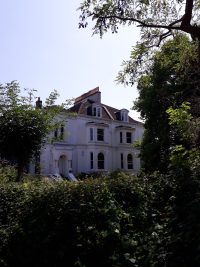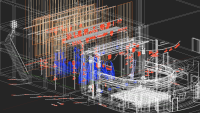
Hugo Dodsworth (he/him)
MA Performance Design
Hugo is a Performance Designer, working holistically across disciplines of set, costume, lighting, and video design. He received his BA (Hons) in Italian and History of Art from UCL in 2021, with the highest marked dissertation in his cohort, titled After Dark: Light as a Material for Placemaking. In 2019, Hugo spent a year working as an electrician and lighting design assistant at Teatro alla Scala in Milan. Hugo specialises in digital design communication methods and is particularly interested in designing for new writing, opera, and dance.
BOVTS credits include Lighting Design for Romeo and Juliet (Redgrave Theatre), Set and Lighting Design for The Last Days of Judas Iscariot (The Station), Production Design for Girl in the Machine (Wardrobe Theatre), Lighting Design for Catastrophe Bay (Bristol Old Vic), Lighting and Projection Design for Loam (Bristol Old Vic).
Previous credits include Little Light (Tower Theatre), Illusion (Bloomsbury Theatre), Not the End of the World (Cockpit Theatre), Saint Joan (Bloomsbury Theatre), Body Shop (Greenside, Edinburgh Festival Fringe), Empty Chair (Pleasance Theatre and Duchess Theatre), Electra (Shaw Theatre), As You Like It (RADA Studio).

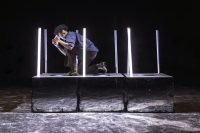
The Last Days of Judas Iscariot
Set in ‘Hope’, downtown Purgatory, Stephen Adly Guirgis’ eccentric courtroom drama sees icons of theology and philosophy take to the stand in the trial of God and the Kingdom of Heaven vs. Judas Iscariot. Complimenting the playwright’s ‘Americanisation’ of the afterlife, my set and lighting design was loosely based on 1970s New York, a period of great economic hardship for the city, and one that saw an explosion of an artistic avant-garde. Inspired by the works of New York Minimalist artists, and their philosophy of ‘what you see is what you see’, my design was stripped of all the iconography associated with the characters that inhabited it, judged only on their words and their actions. Staged in traverse, and using mirrored surfaces, I wanted the audience to feel present and self-aware, fulfilling the role of jury and at times feeling that their own morals were being interrogated. Directed by Nik Partridge, Costume Design by Robbie McDonnell.
Photography credit: Craig Fuller
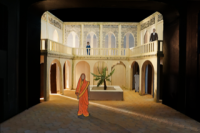
A Doll's House
I took Tanika Gupta’s adaptation of Ibsen’s A Doll’s House as the text for a theoretical design for the Bristol Old Vic Main Stage, working with director Ben Nash. Set in nineteenth century Calcutta, I was particularly interested in how a UK audience might perceive the piece in a time of renewed imperialist rhetoric and racism towards the British-South Asian diaspora. My set design is informed by South Asian architecture, both from the period of British occupation and from the preceding Mughal empire, resulting in a space which feels both familiar and foreign, feelings which challenge us to interrogate our colonial gaze. I wanted Tom and Niru’s house to feel grand and luxurious, yet restrictive and decaying – a symbol of the British empire in South Asia, and of the oppressive force which compounds Niru’s entrapment both as a woman and as a colonial subject. The set has many doors which lead off from a central courtyard. Each presents a possible escape route for Niru, but there is a sense that they all ultimately lead back to the same place and are instead points from which to be silently observed. When Niru does finally leave, it is not through any door on stage, but through the audience.
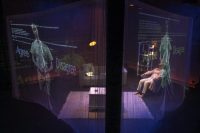
Girl in the Machine
My design for Girl in the Machine (dir. Ellie Jay Stevens) represented a familiar domestic space in the near future. Working with a restricted colour palette for the set and costume, I wanted to create a sense that the real world had lost its vibrancy, appearing banal and bland, and leading Polly to seek ‘bliss’ in the alternate reality of ‘Black Box’, a new technology which offers an escape. Throughout the evening scenes, gauze curtains were drawn around the stage, separating the characters from the audience and trapping them in their own home. When Polly then used ‘Black Box’ we saw her view projected onto the curtains, in the form of an uncanny embodied AI. By the end of the fast-paced play, the tidy plot of urban domesticity was littered with blood, half empty wine glasses, boxes of rationed food, and smashed computer chip boards.
Photography credit: Craig Fuller




